The technological realm stands on the precipice of a profound transformation as the development of augmented reality (AR) devices gathers momentum. Meta, under the leadership of CEO Mark Zuckerberg, is at the forefront of this shift, aiming to redefine how people engage with digital technology by moving beyond traditional smartphones to an ecosystem centered around smart glasses. This bold vision presents a future where digital interactions are more seamless and immersive, paving the way for a radical change in our daily tech experiences.
At the core of Meta’s strategy is the introduction of smart glasses and AR devices that promise more sophisticated digital interactions than what current smartphones offer. The company has embarked on remarkable projects like Supernova and Hypernova, each crafted with unique functionalities to expand upon current technology, providing users with a more comprehensive digital interface. These innovations seek to make the leap from merely refining existing gadgets to unlocking new capabilities and experiences that lie beyond the horizons of today’s digital engagement.
Evolving Beyond Smartphones: The Smart Glasses Revolution
SupernovA New Era for Active Lifestyles
Supernova, inspired by Oakley’s Sphaera sports glasses, represents a significant step forward in wearable technology, particularly tailored for active individuals. With built-in speakers and cameras powered by artificial intelligence, these glasses provide an enhanced hands-free experience, offering essential real-time information. Designed for cyclists and outdoor athletes, users can receive navigation details, weather updates, and even capture moments without needing a smartphone. This paradigm shift suggests a future where devices seamlessly blend with activities, pushing the boundaries of what wearable tech can accomplish.
The practicality of Supernova lies in its ability to integrate voice commands and gesture controls, allowing users to interact with their devices effortlessly. This technology, still in its nascent stages, demonstrates Meta’s commitment to creating innovative solutions that cater to dynamic lifestyles. By focusing on convenience and accessibility, the company endeavors to weave technology into the fabric of everyday movements, ultimately redefining how users perceive and utilize wearable gadgets. The success of such a device heavily leans on consumer acceptance, hinging on the glasses’ ability to outperform existing technology in terms of usability and functionality.
HypernovRedefining Visual Experience
In contrast, Hypernova takes a different approach by incorporating a miniature display within the right lens of the glasses, enabling users to receive updates without diverting attention from their surroundings. Although lacking full AR capabilities, this design marks a significant advancement toward more integrated digital consumption where information overlays in real-time. Feedback from tech enthusiasts has been positive, with many praising the potential of Hypernova to transform how individuals access and process digital information while on the move.
Anticipation is growing around Hypernova’s visual capabilities, which allow users to view messages, notifications, and media directly within their field of vision. While thoroughly tested to ensure optimal performance, this technology has yet to reach mass adoption, primarily due to cost and technical limitations that Meta continues to address. Despite these challenges, the underlying concept of Hypernova suggests a future where digital experiences become more personalized and intuitive, offering a glimpse into what could become a common facet of daily life as the technology matures.
Preparing for the Augmented Reality Transition
Orion and Artemis: Pioneering AR
Meta’s broader ambition dives deeper into the AR sphere, as evidenced by the development of its Orion and Artemis projects. Orion made headlines with its prototype last year, showcasing a comprehensive AR setup with a wristband that reads muscle signals and a processing unit for computational tasks. By incorporating these elements, users can engage in gesture control and realistic interaction with virtual content, extending the potential applications of AR. The implications of such technology reach far beyond mere entertainment, promising profound impacts across industries like education, real estate, and healthcare, where immersive experiences could bring about a new level of engagement and understanding.
Artemis, anticipated to follow Orion’s introduction, is set to make AR more mainstream through a streamlined design fostering ease of use. Despite a hefty price tag—projected at about $10,000 for developers—interest in Orion remains high, driven by its potential to revolutionize user interactions with digital mediums. As Artemis prepares for a commercial release in 2026, its success will largely depend on Meta’s ability to address current limitations, such as cost and complexity, in order to make these technologies accessible to a broader audience. By achieving this, Meta aims to solidify its position as a leader in AR, driving forward an era where augmented reality becomes an integral component of every tech ecosystem.
Expanding the Wearable Ecosystem
Beyond developing its smart glasses, Meta envisions an expansive wearable ecosystem that combines various intelligent devices for a unified digital experience. Notably, the introduction of wireless earbuds equipped with cameras enhances context-awareness by leveraging AI to analyze surroundings in real time. This innovation allows for a more immersive interaction, whereby users receive notifications and responses based on their environment, effectively transforming passive observation into an active exchange of information.
In parallel, Meta is working on a smartwatch designed to harmonize its range of devices into a cohesive, interactive platform. Although facing technical hurdles, the smartwatch could play a pivotal role in realizing Meta’s vision of a connected wearable framework, enabling synchronous operation among devices. Such connectivity opens the possibility for a pervasive digital network, where each device complements the other, creating a seamless interface between users and the digital world. Success hinges on the user’s willingness to adapt from phones to these multifunctional devices—a transition Meta hopes to facilitate through the development of engaging and practical tech solutions.
Navigating Challenges and Charting Future Directions
The tech industry is on the verge of a monumental shift as augmented reality (AR) devices gain traction. Meta, led by CEO Mark Zuckerberg, is spearheading this transformation, with ambitions to revolutionize digital technology use. By focusing on smart glasses, Meta intends to move past traditional smartphones and cultivate a new ecosystem of digital interaction. This pioneering vision suggests a future where digital communication becomes more fluid and immersive, significantly altering everyday tech experiences.
Central to Meta’s plan is the creation of advanced smart glasses and AR devices, designed to offer more nuanced digital interactions than today’s smartphones. Meta is investing in innovative projects like Supernova and Hypernova, each bringing distinct features that enhance current technology and offer users a richer digital experience. These breakthroughs aim not just to improve existing tools but to unlock new possibilities and experiences, surpassing the current limits of digital interaction and setting the stage for a new era in tech engagement.









